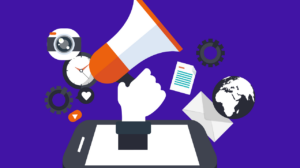Data has become an indispensable part of all business processes, and this is particularly relevant to marketing. Though marketing strategies have always depended on statistics and other valuable data indeed, the game has been completely changed since the upsurge of social media and the big data bang, as it gave rise to numerous sources to get information from.
The global marketing-related data market was valued at $26 billion in 2019, with $15 billion spent in the US only. As BI implementation is only going to become more pervasive, business owners are looking for worthy cases for their data-driven marketing investments, and many recognize targeting as one of the most promising areas in 2020.
A brief introduction to customer targeting
Sometimes also called multi-segment marketing, targeting is a strategy that divides the audience into specific groups of customers based on their characteristics. By studying these groups, companies obtain the opportunity to launch highly-personalized marketing campaigns and thus maximize these customers’ positive response.
Depending on the characteristics chosen, targeting can fall into the following categories:
Demographic segmentation
This one is used to adjust marketing messages to groups of particular age, gender, education, marital status, race, or religion. Related assumptions about targeting may include a middle-aged man who is more likely to be interested in buying a car, or a teenage girl with a high propensity of buying coming-of-age novels.
Psychographic segmentation
Values, beliefs, interests, and lifestyle can also be used for effective targeting: the same store may diversify its messages for dog and cat lovers, vegans and steak fans, and so on.
Geotargeting
Proximity marketing is one of the best ways to boost sales rates, as it helps brands to communicate with customers at the best time and place. Aspects like a customer’s neighborhood, area code, city, region and country can be helpful in launching an engaging marketing campaign.
Behavioral segmentation
Shopping patterns, user status, brand interactions and other characteristics of customers are valuable in terms of finding an individual marketing approach to each buyer. This is the basis of effective personalization efforts.
All of these types can be used separately or combined to achieve better results. However, it’s easier said than done. When it comes to practice, an inevitable question arises: how can I make customer targeting effective for my business?
Tools for successful customer targeting
The key to success lies in choosing an appropriate tool, such as specialized targeting software. Let’s have a closer look at the most efficient ones on the market today.
Adobe Marketing Cloud
Adobe Marketing Cloud stands for a set of Adobe’s digital marketing tools. One of them is Adobe Audience Manager, developed to unify data from a myriad of various sources such as browsing history, social media, and BI systems to deliver a real-time snapshot of customers and provide insights for making advertising as relevant as possible.
Salesforce’s Customer 360 Data Manager
Customer 360 Data Manager collects and unifies data from all the connected external sources of information in order to provide a full view of a customer, identify purchasing trends, and predict customer behavior.
Google Ads
As the world’s leading search engine, Google is the foundation for one of the most well-developed digital display advertising networks, Google Ads. Not only does Google Ads allow promoting your business on search engine results pages, but it also has filters for targeting by gender, location, and many other parameters.
Real-life example of successful customer targeting
Neutrogena, a renowned beauty brand, has nailed its targeting strategy to become a great example of successful marketing campaigns. As the brand realized 75% of their online buyers were only purchasing products within one product segment, they needed a boost to attract new customers and drive sales within other existing product categories. Behavioral targeting was found to be the answer.
The brand analyzed users’ shopping history to identify products they had bought on the internet and show advertisements relevant to the contents of their carts. The approach was aimed at upselling and cross-selling, offering complementary products to loyal customers as well as alternative items from their range for those who had never bought Neutrogena products before. Unobtrusive ads introduced new items to customers as perfect pairings, such as mascara together with makeup removal wipes. The results were impressive — Neutrogena exceeded its benchmarks by 289% with £5.84 return on advertising spend.
Get to know your customer
Today, the digital marketing software range contains a multitude of tools dedicated to gather, analyze and make sense of customer data. The success of any marketing campaign comes down to understanding how to comprehend and make use of this data most effectively when targeting brand messages. In other words, any advertisement that has a potential to convert should have these most important traits:
- It should contain the right message.
- It should be delivered at the right time.
Always start with building up the customer profile. The more precise information you can get, the better. What is their age, gender, occupation, marital status and purchase capacity? What websites do they visit? Social networks? Do they prefer email for communication? Once you formulate your customer profile as precise as possible, dive deep into creating pertinent marketing messages for this market of one.
However, the important thing about data is that it keeps changing. Peoples’ lifestyles are in the state of continuous evolution. It’s crucial to keep track of the changes in your customers’ tastes and needs to stay on top of the competition. At the end of the day, your marketing is only as good as your data management.




